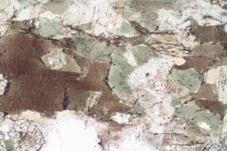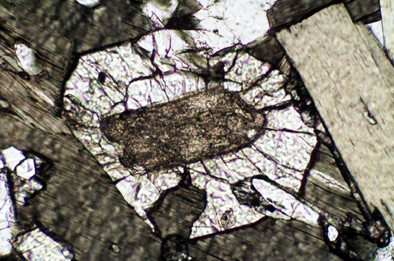Campina Grande Petrography
Roberto Weinberg, Monash University, Australia
Ignez Guimaraes, Universidade Federal de Pernambuco
Neysi Almeida, Universidade Federal de Pernambuco
In the Campina Grande pluton there is evidence for the mingling and mixing of pegmatitic granites and diorites. This is unusual and because of the combination of low viscosity and low solidus temperature of the pegmatitic melts, combined with extreme fractionation, the mingling of these two melts has many distinctive features when compared to the mingling of granite and diorite magmas.
Morgan and London (1987, Am. Mineral. 72, p. 1097-1121) describe the metasomatic alteration of a pre-existing amphibolite upon intrusion and crystallization of an evolved pegmatite rich in rare elements. They determine three stages of alteration. The first stage defined is characterized by B-alteration, and is associated with tourmaline, as well as tit, calc etc. The second stage was termed the K-Rb-Cs-F alteration and lead to the growth of bt. The third stage was propylitization with the alteration of hbl+pl to ep+chl+tit+cal+ clay. We found that during the mingling hystory, that a modified version of the same pattern can be followed.
Major Summarizing Features
Contact felsic-mafic:
Dendritic at a range of scales. Growth of large hbl crystals (FD01,
FD16), tit (FD16) and opaques (FD01).
Py, minor cpy, enriched at mingled contacts. Best developed in FD01,
where a large op grows at contact and small grains are more common
close to the contact.
Diorite close to granite contacts develop two types of characteristic textures: poikilitic or orbicular honeycomb textures.
Poikilitic texture:
crystals of plagioclase (e.g. FD4a) and bt (eg FD4a, b). In some cases
the poikilocrystals are interstitial and zoned (FD3b), in one case hbl
is also poikilitic (FD3b). Biotitization of the diorite is a typical
feature of contact diorite+pegmatite.
Orbicular honeycomb texture :
samples FD3b, 6.8A, 09 and 13. Zoned orbicules with hbl surrounding
cores of aug+op or aug+qz (symplectite). These orbicules have few bt.
Typically these rocks have a very characteristic “orbicular and
honeycomb” texture, where the orbicules are embedded in a
fine-grained
mesh of predominantly bt+pl and minor hbl. In some cases you have bt
around hbl (best around FD6.8A). Typically hbl has tiny qz worm
inclusions (best developed in FD6.8A). Sometime rather than orbicules
there are amph. aggregates (FD6.8A).
Hydrothermal alteration:
Paths of alteration to greenschist facies minerals (act+chl+ep (+ab?))
FD201b (best example), blebs of aug within hbl, ep alteration at
contacts hbl-pl (use FD5.1 to define the nature of these pathways)
Paths of pl alteration to dust and sericite, in one case alteration
follows a zone around a crack: FD201b, FD3b.
Narrow zones of Kf recrystallization (FD16, best in FD5.1A), which I suspect is alteration, possibly to ab, and possibly tml or act?
Tourmaline in diorite:
Tourmaline grains are found within hornblende (as inclusions; sample
FD202) as well as within pegmatite (FD06.9), suggesting
a B alteration of the diorite. The timing of alteration is unclear but
the fact that tml is found within well formed diorite
hbl suggests early formation.
Biotite surrounding plagioclase parallel to faces. FD16
Interpretation: the poikilitic, orbicular textures are a signature of instability during mixing
Question: is the hydrothermal greenschist facies alteration, and patches of act in hbl a result of alteration from fluids released by low-temperature crystallization of pegmatites (400-500 C)?
If this is so, mingling has a super-solidus effect on diorite giving rise to the textures and growth of bt through possible addition of potassium, and a sub-solidus effect with partial alteration to greenschist facies assemblages. The latter might be impossible to solve, but all of it can be indicated by geochemistry.
-
samples with * have geochemistry
- *FD12.3: Bt-hbl-gr leucogranite
- FD13: Orbicular diorite contact with porphyritic granite
- FD09: Diorite mingled with granite
- *FD201B: Hbl-bt-aug diorite hydrotermally altered
- *FD03B: Pan-poikilitic diorite
- FD04A: Pan-poikilitic diorite
- FD04B: Pan-poikilitic diorite
- FD5.1A: Granodiorite mingled pegmatite
- FD6.8A: Diorite mingled pegmatite
- FD6.8B: Diorite mingled pegmatite
- *FD202: Deformed diorite
- *FD08: Leucogranite
- FD01: Mingled diorite and granodiorite
- FD6.9: Mingled diorite and pegmatite
- FD200: Mylonitic mingled granite-diorite
- *FD16: Mingled granite-diorite
- *FD11.1: Mingled granite-diorite
FD12.3: Bt-hbl-gr leucogranite
Texture:porphyritic aggregate/cumulate texture deformed syn- magmatically (broken phenocrysts with cracks intruded by qz+bt) and subsolidus (recrystallized qz)
Plagioclase:
subedric laths with irregular margins in one grain a beautiful single
lamella altered to a single ms crystal and another with a wider band of
bt
occurs also as altered (cc+ep+ser and dust) inclusions in Kf
some large crystals are beautifully fractured with intervening qz+bt
lammelae extinction angle 5
K-feldspar:
phenocrysts, myrmekite, tartan twinning
cracked, cracks filled by qz + ep
inclusions of altered pl
Quartz:
Matrix finely recrystallized to perfect new grains
Biotite:
In plag marginsand in small aggregates with hbl
Hornblende
green pleochroism, small irregular grains
Accessories: titanite, apatite, garnet (isotropic hexagons much larger than any apatites, occur within a mafic aggregate)
Alteration: chlorite, cc, epidote
Photographs to do: sphene in crack within phenocryst, altered single lamella, cracked phenoc and indentation
FD13: Orbicular diorite contact with porphyritic granite
A) Orbicular diorite contact, 2.5
cm view 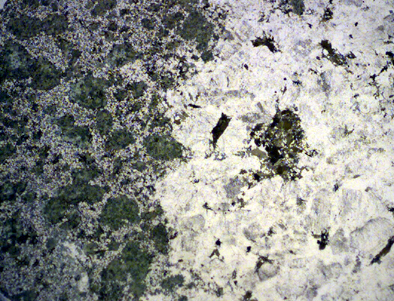
|
B) Two zoned orbicules, 5 mm
across 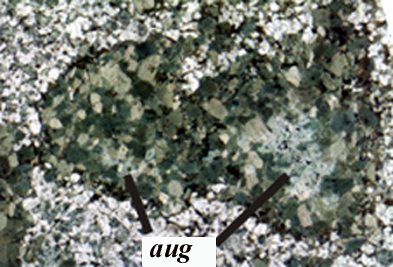
|
C) Honeycomb texture, 1.5 mm across 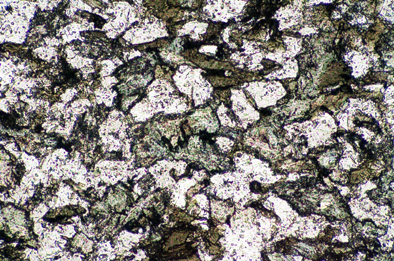
|
D) Honeycomb texture, 1.5 mm
across 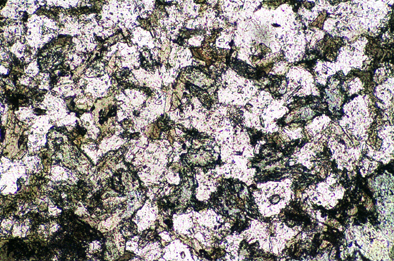
|
Texture. diorite: orbicules in honey-comb mesh, different from other honey-comb textures in C.G. this sample has hbl+bt+pl in the honeycomb mesh, while others have bt+pl and hbl grows separately and tend to form larger isolated crystals (see FD09 and 6.8A).
Diorite: 1-5 mm elliptical nodules of pure of amphibole with 10% bt laths but no plag. Nodules embedded in a fine rock of hbl+pl+bt. Nodules are zoned with pleochr. hbl surrounding aug+tiny opaques in nodule cores (weak green pleochr.)
Irregular contact with granite. There is bt aggregate within the granite linked to the diorite through a very narrow isthmus, and this aggregate has no amphiboles, unlike all mafic aggregates in diorite suggesting amphiboles became unstable.
Plagioclase:
poikilitic interstitial (bt+hbl inclusions)
Biotite:
Forms an aggregate within granite but physically linked to diorite and
associated with lots of sphene, zircon, and large apatite
Hornblende:
green pleochroism
Augite:
perhaps a few remnants
Augite:
weak pleochr.
Accessories: titanite, zircon staining bt
Pegmatitic granite
Kf phenocrysts: irregular with plag inclusions and apatite
Quartz: recrystallized matrix
Biotite
Accessories: sphene apatite, py, cpy (opaques)
FD09: Diorite mingled with granite
Texture:Orbicules in meshed matrix diorite mingled with sheared granite
Amphibole orbicules are zoned with hbl surrounding aug cores which have small qz(?) worms (see also FD3b and FD13). Orbicules are embedded in a fine matrix that is a mesh of predominantly bt and pl, and less hbl plus accessories
A) Orbicular diorite contact, 2.5
cm view 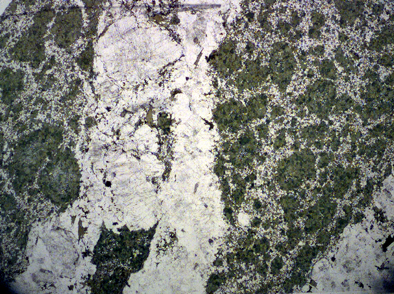
|
B) Two zoned orbicules, 7 mm
across 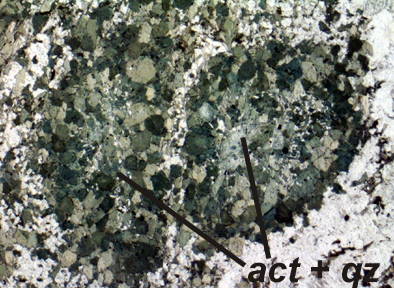
|
C) Zoned orbicule, 3.5 mm across 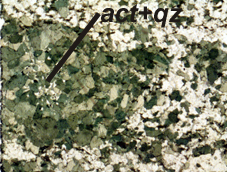
|
D) Honeycomb text, 1.5 mm across 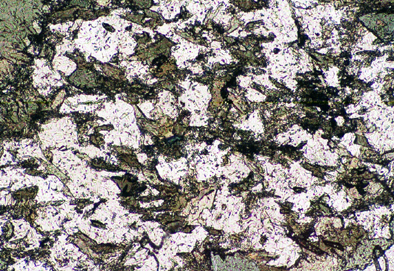
|
FD201B: Hbl-bt-aug diorite hydrotermally altered
Texture:
Plagioclase:
well-developed twin lamellae, not zoned, and poorly twinned zoned,
altered to dusty plag and sericite along pathways and irregularly
showing fluid paths. Extinction angle 23-24. Deformation:
recrystallized grains, bent lamellae and fractured grains .
Amphiboles:
strongly pleochr. hbl, weakly pleoch. aug. Inside hbl grains there are
patches of preserved aug and fine grained ep (one case where a large ep
grain grows inside a hbl crystal and is surrounded by an augrim). In
many cases act seems to grade to hbl.
Fluid pathways:
can be tracked trough the sample causing the break down of hbl+pl to ep
(along mutual contacts between hbl+pl) and hbl to act. Sometimes there
is evidence for a breakdown of hbl into ep+act in fine intergrowth, or
hbl to ep+qz (?). Bt is locally altered to chl (anomalous blue pleoch.)
Epidote:
lots (not so obviously primary as in some other samples of
the C. Grande)
Accessories:
tit, ap
Alteration:
ep, sericite, chl
FD03B: Pan-poikilitic diorite
Texture:
fully poikilitic, large zoned interstitial pl
including hbl + bt, large hbl
FD04A: Pan-poikilitic diorite mingled with pegmatite
Texture:
Poikilitic bt phenocrysts (>1cm long) with
inclusions of aug (weak green) surrounded by grains of hbl (green
pleochr)
Granite
Quartz:
in granite 1 cm across (normally 0.5 cm or less) irregular shape
Microcline:
perthite, up to 0.5cm across, flame perthite, anhedral,
dirty aspect.
Plagioclase zoned poikilitic anhedral interstitial up to 8mm wide
continuous across other grain masses within granite (see FD3b).
Biotite:
few small grains
Irregular contacts with diorite
Diorite
Few pl grains in mafic part.
Hornblende:
forms phenocrystals as well
Augite grade to hbl with stronger pleochroism
Biotite:
poikilitic phenocryst (3-8 mm long) slightly deformed.
There is a tendency for
amphibole inclusions in bt being transparent or weakly green pleochroic
compared to those
outside. Lots of epidote inclusion
Epidote:
inclusions in bt
Rapid cooling and addition of water and K gives rise to pan-poikil. texture and growth of bt.
Difference to other rocks is that this one is intensely retrogressed with few hbl left.
FD04B: Pan-poikilitic diorite
Texture:
Poikilitic bt phenocrysts (>1cm long) with
inclusions of aug (weak green) surrounded by grains of hbl (green
pleochr)
Hbl forms phenocrystals as well
Plagioclase zoned poikilitic anhedral interstitial up to 5mm wide continuous across other grain masses (like FD3b). Hydrothermal alteration gives rise to dirty plagioclase randomly spread over the thin section (not defining pathways).
Rapid cooling and addition of water and K gives rise to pan-poikil. texture and growth of bt.
A) Poikilitic biotite 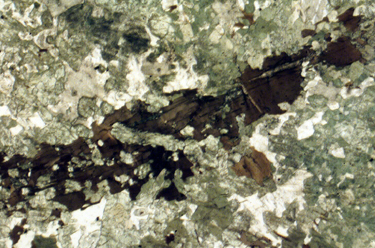
|
B) Poikilitic biotite 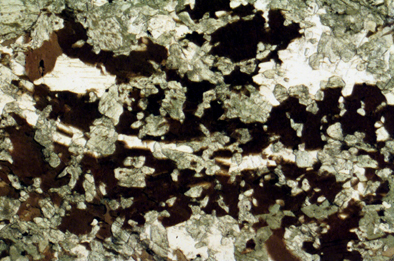
|
C) Poikilitic intestitial
plagioclase 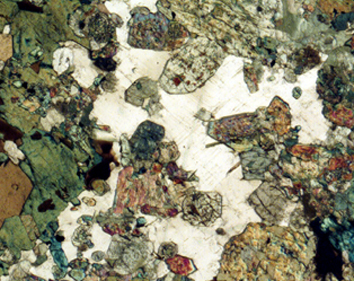 |
D) Poikilitic intestitial
plagioclase
|
FD5.1A: Granodiorite mingled pegmatite
Texture:
Granodiorite: bt-rich and no amph. nodules bt+hbl+pl+ep+all
When mafic protrudes into felsic you have what looks like a recrystallized band within large Kfeld where there are op, bt, myrmekite and titanite (seed also FD6.8) and fibrous tremolite (could it be tml?). It is possible that these “recrystallized” paths are really true mixed material and these can be followed for over 2cm. These recrystallized paths follow the boundaries of Kf.
Accessories: lots of ap and zr, all, ep
tit: as alteration product, xenomorphic ep+all: forming corona textures, euhedral ep. 0.5 mm across, with a core of all. 0.2 mm. Four grains like this, all associated with bt.
A) Ep+all corona 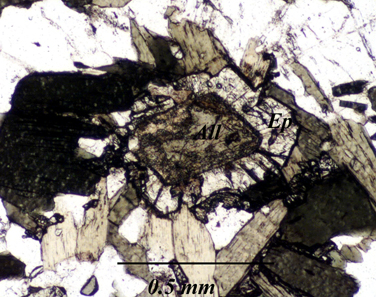 |
B) Ep+all corona |
Chlorite alteration (one grain)
Qz normally well formed coarse and underformed suggesting that the fine bands in Kf and their contacts are not a result of deformation but a result of fluid paths.
We need to establish what is in these paths: they are either fluid paths released from the mafic protrusion or whether they are regional fluid paths.
FD6.8A: Diorite mingled pegmatite
Texture:
honeycomb (this is the best mesh) and aggregates. amphiboles form
aggregates of the same nature of orbicules but do not have the orbicule
shape. Out of a protrusion of mafic material there is micrometer thin
band of amphiboles within pegmatite. Mafic protrusion englobe single pl
crystals from pegmatite. Tit and op (cpy+py) develop at the tip of
mafic protrusions.
Amph. form phenocrysts up to 4 mm long, generally about 1 mm long and are also in matrix. Some aug have very well developed qz worm inclusions and they are surrounded by bt grains (in one case 100% of the amph).
Allanite (single grain at contact Pegm-dior)
FD6.8B: Diorite mingled pegmatite
Texture:orbicular honeycomb (not zoned orbicules)
Hbl phenocr with qz worms, hbl aggregates cored by aug?, small grains aggregate
There are two sorts of qz inclusions in hbl-aug. One is a wormy narrow qz related to hbl loosing pleochr, another which are larger rounded qz blobe which could be just plain inclusions in hbl that do not look altered to act.
The aggregates like in other thin section are bt poor
Like in sample FD4B there are fluid pathways evidenced by alteration (but not very clear)
FD202: Deformed tml diorite
Texture:
phenocrysts of plag and Kf (few perthite exsolution).
Deformation: crystal preferred orientation and gneissosity. Fracture
band cuts across thin section filled with very fine brown pleochroic
material (possibly bt).
Hbl: yellow to green pleochroism, seriate size distribution, includes ep. in core and ap, some grains look like hbl embayed by qz. Hbl has small wormy inclusions of qz, emabayed pl, and tml inclusions. Hbl phenocryst with a core that looks to be aug (weak green pleochr.)
Tml: inclusions in hbl. Zoned pleochroism from brown to yellow, anomalour interference colours depicting zoning from brown to blueish colours. Inclusions are either elongated but not needles or rounded
Tml+pl inclusion in hbl 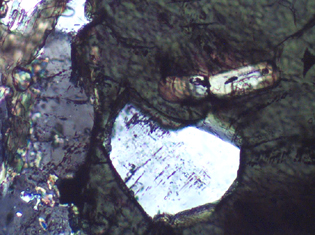
|
Aug: associated with hbl alteration to epidote
Pl: zoned, twinning, bent lamellae, <30 degrees extinction angle (andesine) up to 3mm
Kf: up to 3mm equidimensional include mafic aggregate of bt+op+sph+ap and pl
Epidote: well formed tending to euhedric but some anhedric, high relief, transparent grains associated with hbl alteration Qz: intergrown with hbl, similar to that in other mingled mafic rocks.(? meaning?)
Tit: large poorly developed grains, interstitial anhedric and stained surface
Matrix <0.5 mm
Ap: Lots of ap grains, long needles and well formed grains.
FD08: Leucogranite
Texture:
Coarse, dirty, hydrothermally altered leucogranite
Fibrous tourmaline: light brown to light green pleochroism growing around a grain of qz Biotite: light brown to dark brown forms shlieren associated with opaques, specially around individual isolated bt grains + ap+ep+zr+tit. Bt has a pointy, spidery shape
Tourmaline: tml, long gerains pleochroism brown to light brown, right angle extinction, grows close to bt, one grain 0.1 mm long, 0.015 mm wide Opaque trail, interstitial, 6 mm long 1 mm wide
Kfeldspar: flame perthite, myrmekite, 3mm long, poorly developed Karlsbad twins.
Plagioclase: dusty, equant upto 2mm, some qz intergrowth, and pl as inclusions with corroded margins in Kf 0.5 mm in size
Quartz: new grains/ondulose extinction upto 4mm across
Epidote: in bt aggregate, sometimes euhedral
Zircon: many grains in bt aggregate, causing stains in bt. Lots of zr everywhere and other unrecognized alteration minerals. Finely recrystallized material within Kf (0.1 mm wide band) which looks like fluid paths (no minerals could be determined)
FD01: Diorite mingled with granodiorite
Texture:
Mingled unstable texture with incipient orbicular
texture.
Diorite: hbl, pl, bt diorite, fine grained, 0.1-0.2mm long with hbl phenocrysts, up to 1.5 cm close to granodiorite pods, as well as orbicules up to 1.5 mm wide, with fine opaque grains and aug in the core. There is a phenocrystal with opaque grains, and other hbl aggregates, orbicular like but without aug and the rounded shape. This is a case of incipient orbicular text. and the orbicules, aggregates and phenocrysts aqre all close to the granodiorite pods indicating that they are a result of mingling.
Plagioclase: patches where they are saussuritized and dusty, other areas plagioclase are pristine.
Opaques: tend to be heterog. distributed, small grains in dior. are richer close to the granodiorite pods. Large opaque, poikilitic phenocrystal at contact (2 mm).
Granodiorite pods:
these are coarse grained hbl-poor,
bt-rich, and titanite altered pods, with margins rich in coarse hbl and
op.
Plagioclase: tend to form continuous grains without clear boundaries. Saussuritized and with large calcite grains plus op and seric as alteration.
? high birefringence colour, straight extinction, fibrous alteration mineral(?) related to pl.
FD6.9: Mingled diorite and tml pegmatite
Texture:
Deformed and locally mylonitic pegmatite
Bt in pegmatite: single crystal >1cm across, beautiful internal deformation, within pegmatite. Includes long needles of radial tml (right-angle ext). My reading of the ts, is that early formed bt grains were subsequently altered by the pegmatitic fluids to tit+tml along bt grain margins
A) Tml needles in bt 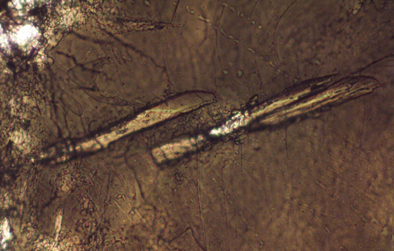 |
B) Tml needles in bt 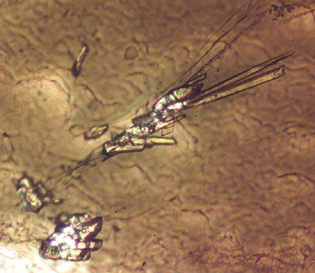 |
Qz: fully recrystallized coarse grains
Pl: deformed
Kf: deformed, mylonitic very fine grained. Coarse, with myrmekite on margins
No alteration products related to mylonitization of feldspars such as sericite, cc or ep, suggesting amphibolite facies deformation
Tml: occurs as inclusion needles in bt, but also as fine amorphous crystal swarms with green pleochroism which I thought first to to be hbl, but has right-angle extinction in long sections
Mafic rock is composed of hbl+bt+pl+Kf+ accessories
Biotite in diorite masses of zircon inclusions (>50 grains in a small patch; high relief, prismatic, high interference colours) as well as ep+tit.
FD200: Mylonitic mingled granite-diorite
Texture:
Porphyritic band of felsic ultramylonite within a
diorite partly ultramylonitic and partly
preserved (beautiful)
FD16: Mingled granite-diorite
Texture:
preferred orientation due to deformation. Contact
mafic-felsic characterized by largest grains of
hbl, large tit
Diorite:
Hbl: dark green pleochroism, local crystal faces, well formed twins
surroudnde by fine groundmass of bt.
Preserved aug in a few crystals. Hbl unstable: pleochroism becomes pale
suggesting aug. Also intergrowth/
inclusions of quartz
Aug: in hbl
Pl: large crystal (ovoids), recrystallized, bent lammellae. Surrounded by bt parallel to faces
Kf: microcline perthitic
Accessories: tit, ap, op, zr
Contact:
large hbl grains
tit: at contact, large, twinned grains
Kf: recrystallized, complex internal deformation
Granite:
Kf: tartan twinning, deformed internally recrystallized. Fine bands of
recrystallization (like many other samples).
Qz: fully recrystallized to very small grains
Bt: very few
FD11.1: mylonite in pegmatite (ts broke)
Texture:
mylonite developed in pegmatite. High-T deformation
of pegmatite comparable to FD6.9. Throughout the entire section there
are parallel bands of dusty alteration overprintint the feldspars
(never seen anything like it). Mylonite
band separates a region characterized by phenocrysts of feldspar (Kf no
twinning no perthite) swimming in recrystallized qz, from a zone of
much coarser microcline (1.5 cm) fully perthitic and with
well-developed tartan twinning.
Kf: on ome side of mylonite phenocrysts fractured and broken embedded in a recrystallized qz matrix. Beautiful high-T bending of Kf lammellae (broad kink bands), and finer grained recrystallized Kf tails. No twinning, no perthite (one little patch found), cut by parallel dusty lines, ondulose extinction and recrystallized. On the other side the microcline is twinned, perthitic and coarser 1.5 cm long (a different phase altogether).
Pl: unaltered, cut by parallel dusty lines of alteration
Qz: polygonal recrystallized grains
Bt+ep: low modal percentage
Ep filled cracks across Kf Hbl: green inclusion in Kf (is it tml?)
